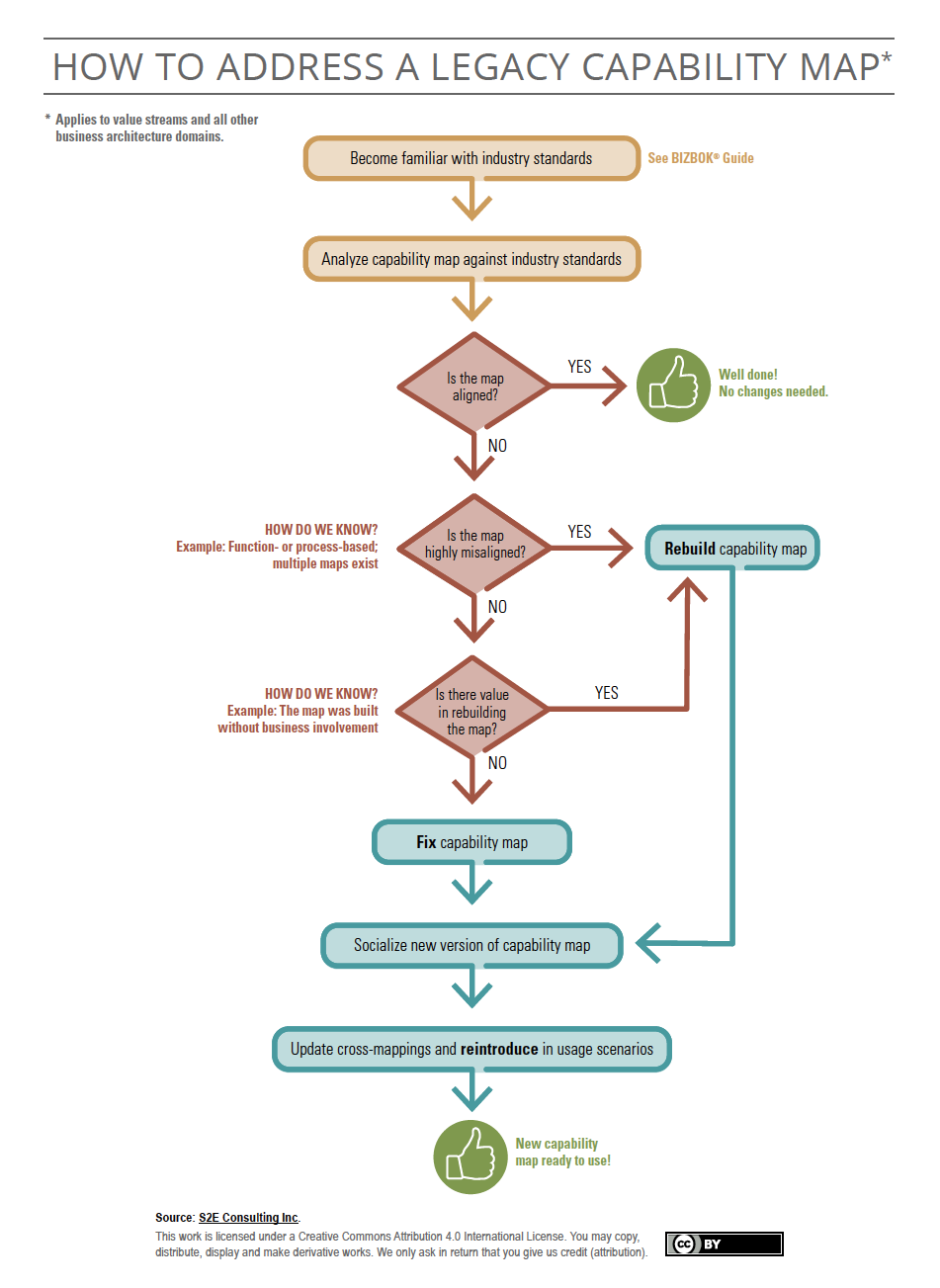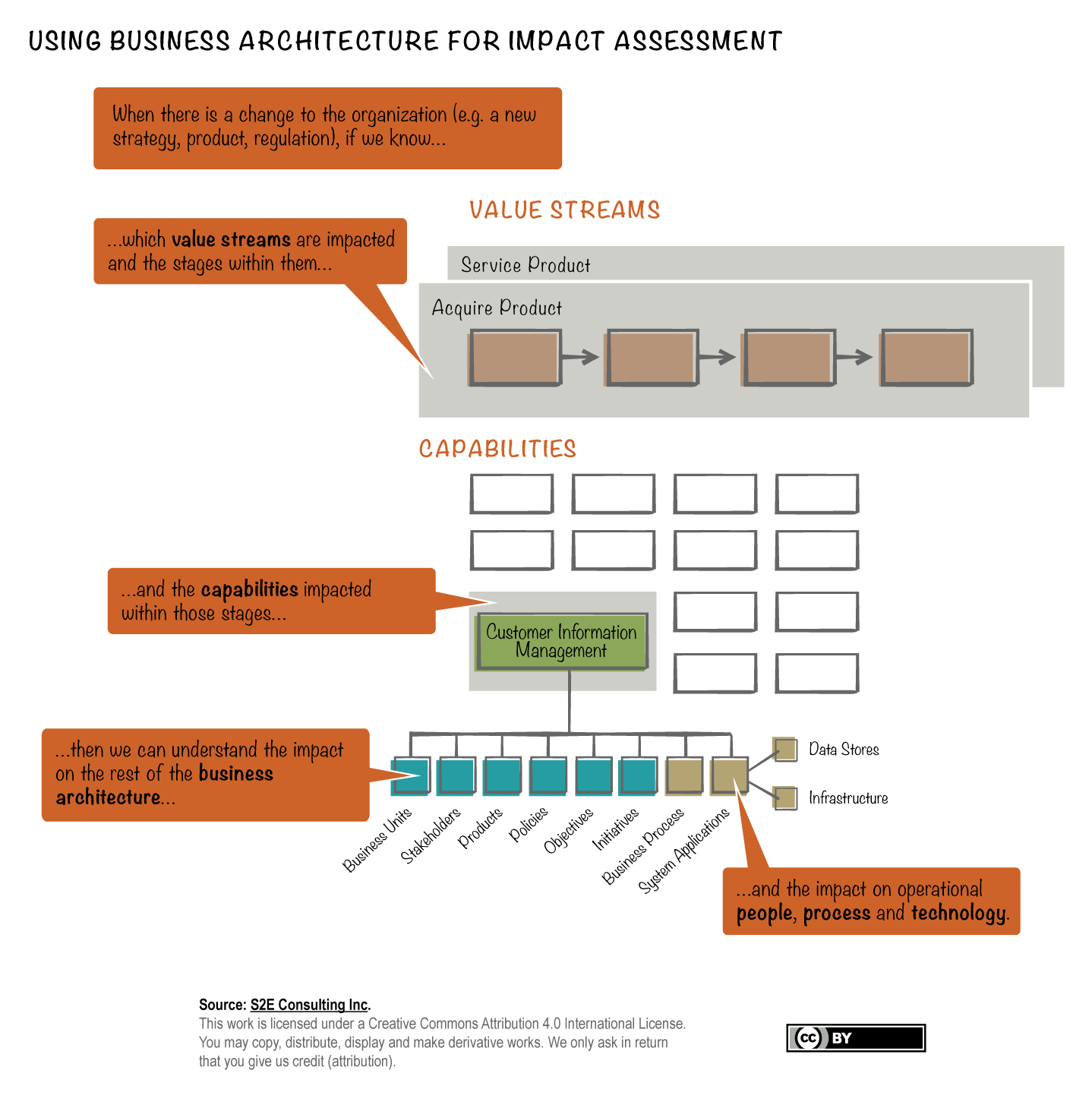![]() We’re back with another installment in the “how to deal” series. This post focuses on how to deal with legacy business architecture challenges (a.k.a. you realize the business architecture knowledgebase you built is not quite right). This is a common situation for business architecture teams which have been at this for awhile—though there are important lessons to heed here for new teams as well.
We’re back with another installment in the “how to deal” series. This post focuses on how to deal with legacy business architecture challenges (a.k.a. you realize the business architecture knowledgebase you built is not quite right). This is a common situation for business architecture teams which have been at this for awhile—though there are important lessons to heed here for new teams as well.
What are some common challenges to watch for?
Here are the most common things that happen in organizations:
- Your business architecture does not align with the current industry principles and best practices – This happens the most frequently with capability maps* and value streams, but can apply to any domain within the business architecture. For example, many legacy capability maps are closer to functional decompositions or some sort of process groupings versus being business object-based as defined in the BIZBOK® Guide. Sometimes legacy value streams can turn into something more like high-level processes or end-to-end life cycles, and often have more of an internal focus versus the intended stakeholder value focus.
- Your business architecture is not centralized – This is when multiple different business units or product areas create “their own” business architectures. There is a lot of flexibility in practicing business architecture, but one of the most fundamental and immutable principles is that there must be one business architecture for an organization (unless it is a conglomerate or another special situation). Otherwise, we are just recreating and enforcing the silos in place today—when the focus of this discipline is to bring them together. More on this foundation in No. 12.
- The scope of your business architecture differs from the industry definition – The scope of what is and is not business architecture has been concretely defined for some length of time by the Business Architecture Guild® in collaboration with a number of other industry organizations. However, it is not uncommon for organizations to define the scope differently—either by leaving out some key domains (e.g. products and policies) or adding in some extras (e.g. process, which is not “part of” business architecture, but rather is a related discipline which is aligned with it). No. 1 lays out the scope of business architecture.
* P.S. Speaking of industry alignment, the BIZBOK® Guide has standardized around the term “map” versus “model” (e.g. capability map not capability model).
How do these challenges happen?
It’s all good. It’s usually due to the fact that the business architecture discipline has evolved, matured, formalized and standardized to a great extent over the years, especially with the formation of the Business Architecture Guild® in 2010 and everything that has come with it. That includes as the BIZBOK® Guide (body of knowledge), global business architecture practitioner collaboration, certification, training accreditation, standards establishment and more.
Misalignment can also happen when organizations do not invest properly in their business architecture team or practice in the beginning, leaving the success of the practice to be based on Google searches versus solid training or help.
If you work on a new business architecture team, you have the opportunity to get started off on the right foot and build a solid foundation from the start. (And hopefully, you won’t ever need to read this post again in the future after you’ve built your architecture).
How do we know if our business architecture is industry aligned?
It’s best to go directly to the source. Review the principles, best practices and examples in the BIZBOK® Guide (and any Guild webinars) to understand the industry direction and then compare your business architecture to it. You can also consult with an expert to help you through this process. (Just make sure they are aligned with the BIZBOK® Guide, not their own definition of business architecture.)
Our organization’s business architecture is not fully aligned with the industry. But really, so what?
This is not about an academic discussion (and if it was we wouldn’t bring it up because we are focused on practical business value). The benefits of aligning with industry principles and best practices are:
- It works – The industry direction has been built by practitioners globally from all sorts of different organizations and geographies, based on years and years of experience. And it works in practice. For example, the idea of building a business object-based capability map was created out of the need for an entirely unique view of an organization that highlights areas of sameness and potential collaboration—not another one which reemphasizes the siloed views we have today.
- It greatly increases effectiveness – Not only is the industry direction based on what works in practice, but when practitioners and organizations adopt a common frame of reference (which is what we architects are all about) it makes learning from and collaborating with each other easier, hiring new business architects for our team easier, and getting up to speed easier.
Both of these reasons equal less time building and arguing about business architecture, and more time actually using it, because our jobs are to deliver value to our organizations.
What next then if our business architecture is not fully industry aligned?
If you are asking this question then you’ve already taken the first step. First, take comfort in the fact that this is always a journey and you are certainly not alone. Take the time to fully analyze the situation and determine what steps need to be taken. Start by fixing your capability map and value streams (or creating them if you don’t have them). Refer to No. 22 for some tips on how to quickly and effectively build a business architecture knowledgebase. Enlist an expert here if you need one.
Some organizations phase in changes to their business architecture over time and some make all of them at once and roll them all out together. The best approach depends on your organization dynamics, such as the level of usage and adoption of your business architecture. Socialization and messaging are very important here so that everyone understands why the changes are being made and what the benefits will be.
Okay, details, details. What do we do if our capability map is not industry aligned?
The quick answer (which applies to capability maps as well as any other aspect of business architecture) is that you have one of two options here: fix it or rebuild it.
Keep in mind that fixing can take a lot more time (and headache) than rebuilding it from scratch. The diagram below lays out a thought process to help you decide and move forward.
But what about all the things we have tied to our current capability map?
Organizations frequently have many system applications or other types of content cross-mapped to their capabilities. Here are a couple commonly used options to address this:
- Update the cross-mappings from the legacy capability map to the new capability map now.
- Create a translation between the legacy capability map and the new one, and allow the legacy capability map to be used for the existing relationships (this is a good solution to allow for the new capability map to prove itself and be phased in later).
In each of these cases, communication and partnership are key to success and adoption.
What do we do if we’ve built our business architecture in a fragmented way across business units (or product areas or projects)?
To fully leverage the business architecture discipline within your organization, you will need to transition to a centralized business architecture knowledgebase. However, make a plan to get there over time.
You can and should start now by creating an enterprise-wide capability map and set of value streams. You can either build them by rationalizing and consolidating all of the individual capability maps and value streams—or you can rebuild from scratch. Often the latter is easier and leverages the hard work and content that went into the individual views, yet facilitates a new level of collaboration and creates a collective team result.
What do we do if we’ve defined the scope of business architecture in our organization differently?
If you’ve put fewer domains in the scope of business architecture, the answer is easy. Identify what is missing and build out that content over time. Once capabilities and value streams are in place, everything else can be created opportunistically as you have a real business need to use it. More on that in post No. 13.
If you’ve put additional domains in the scope of business architecture that should not be there, this can be a bit trickier. But again, determine where you want to go and make a plan to get there over time. This might include finding new owners (and redefining the business architect and other roles) for things you’ve included in scope which are actually separate disciplines.
Closing Comments: Business architecture is a continually evolving discipline and that’s part of what makes it so exciting. Stay on top of future developments—and even better, become a part of the global community that is shaping them.
More Good Stuff…
20 Minute Capability Mapping and 20 Minute Value Stream Mapping (BA Guild webinars): Two of the most listened to webinars on capability and value stream mapping. These are Guild classics and essential if you are building—or rebuilding—your capability map and value streams.
Business Architecture Reference Models (BIZBOK® Guide): You can view business architecture reference model content in Part 8 of the BIZBOK® Guide (Business Architecture Guild® membership required). Downloadable content is also available (free to members) in the Store.
Join a Guild Group (BA Guild): Join a Guild collaborative team to help shape capability maps, value streams and other reference models—or contribute thought leadership on a variety of other important topics. (Requires BA Guild membership.)
What is Business Architecture? (S2E white paper): Just in case you missed it, this white paper is a really handy one that breaks down what business architecture really is—and isn’t.
5 Ways to Leave a Great Legacy (Huff Post): Just for inspiration. Because legacies are for more than just business architecture.
5 Ted Talks to Help You Live a Rewarding Life & Create a Legacy (Bonne Vie): A compilation of five incredible TED Talks which teach us the key skills and mindset needed to achieve success and joy in life, and work in a way that inspires others. These are worth your time.


